what should you do if your atv starts to tip while you are turning at a moderate speed?
Every ATV rider was at i fourth dimension a beginner. We all had to survive the first-day jitters as we learned the bones riding techniques of riding an all-terrain vehicle. For most people, this experience is both fun and challenging. By the cease of the day, new ATV riders feel a groovy sense of achievement and are excited about the new sport they've discovered.
However, the first 24-hour interval of riding can also be somewhat risky. That'southward why safety is paramount while learning basic ATV riding skills.
The best matter for every new rider is to enroll in an ATV Safety Found (ASI) ATV RiderCourse. It'due south not expensive, and if you're ownership a new quad, you lot volition probably get a certificate to take the course for gratis. Certified ASI instructors conduct courses at diverse locations throughout the The states.
Still, taking the class is not always possible for all riders, so hither is some advice on a similar footstep-by-step training procedure.
Know Your Machine
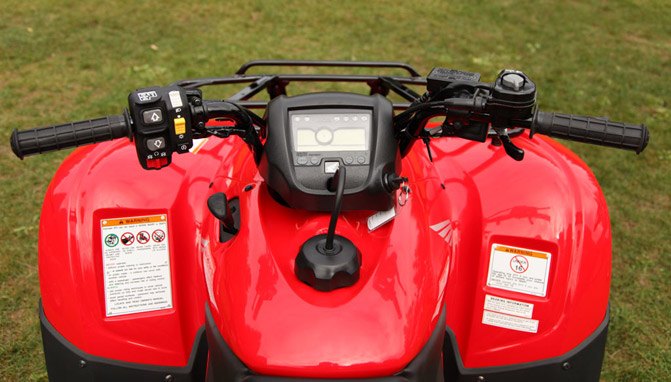
The first thing to do is carefully read your possessor's manual and become familiar with the way your auto works. As you read the manual, sit on the ATV and become a good experience for where all the controls are. So figure out the proper process for starting. Where is the asphyxiate?
Pre-Ride Inspection
Inspecting the mechanical condition of your ATV before each ride is important to minimize the chance of existence injured or stranded. This too ensures long enjoyment of your ATV. Recall, you can ride further in i hr than you can walk in a day.
The first step in this procedure is to cheque your tire pressure. If the tires on one side of your quad are not the aforementioned pressure level as the corresponding tires on the other side, information technology will affect your handling. Over-inflated tires may get damaged and under-inflated tires can ruin the rims. You'll need a depression-pressure tire approximate to get the job done.
Next, check the wheel nuts, axle basics and grab the tires and rock them back and along to attempt and detect worn-out bearings. Too, test the action of the brake levers, throttle, and human foot shifter. If your ATV features an adjustable throttle limiter, make sure the adjustment is advisable for the rider.
You should always take a peak at the oil, fuel, and coolant levels, as well as look for any leaks in the various systems. Then check the bondage and sprockets (if applicable) for acceptable adjustment, wear and proper lubrication. Wiggle the handlebars back and along, looking for whatever loose connections. Make sure y'all're carrying a tool kit and any other emergency equipment you may experience you need.
Exercise Area
Choose a big (almost 100 by 200 feet), flat, open practice expanse, costless of obstacles and hazards, to use while you practice. The terrain should be flat for all the exercises described here except for the hill exercises. Practicing on a hard dirt surface will get in easier for you to larn the basic maneuvers.
Do not exercise these exercises on public roads or paved surfaces. ATVs are designed for off-road use only.
For your markers, you'll need five objects—these can be milk cartons or plastic bottles with sand in them. Do not use drinking glass bottles or other breakable items, though. You should also bring a tape measure to marker your distances, or at to the lowest degree measure your footstep so yous can step off the distances.
Proper Posture
The right riding posture will help you to easily operate the controls and help you lot react more quickly when shifting your body weight. Proper straight-line riding posture includes:
- Caput and eyes up, looking well ahead.
- Shoulders relaxed, elbows aptitude slightly out, abroad from your body.
- Hands on the handlebars.
- Knees in towards the gas tank.
- Feet on footrests, toes pointing straight ahead.
ATVs are rider-active, and then to enhance the performance capabilities of the machine, you must shift your trunk weight. This is specially truthful in maneuvers such as turning, negotiating hills, and crossing obstacles.
Starting and Stopping
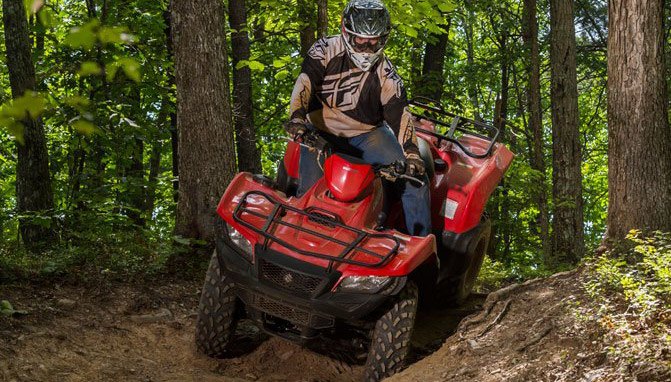
The first thing to work on is just starting and stopping in a direct line. Fix ii markers, about 100 feet from your starting bespeak. In first or low gear, ride to the markers (riders with a clutch volition accept a chance here to learn how to release information technology slowly) and slow down before you accomplish the markers. Come to a smooth, non-skidding cease using both the forepart and rear brakes, with your front end tires betwixt the markers.
Then, if you accept a shifting model, do the course again, taking off in kickoff and shifting to second, and and so downshifting to first as you lot first braking. Whether yous take an automatic transmission or a manual transmission ATV, do this procedure several times, increasing your speed slightly each time.
Next, try a similar stopping exercise in a corner. Take turns stopping at marker C and D, increasing your speed as you lot feel more comfortable. Be careful to not overshoot the corner or slip while braking.
Turning Nuts
The post-obit basic turning techniques use to ATVs being ridden at low to moderate speeds:
- Move your body weight forrad and to the inside of the turn.
- Turn the handlebars while looking in the direction of the turn.
- As you increase your speed or turn more than sharply, move your body weight farther toward the inside of the turn to maintain your residue.
- If your ATV starts to tip while turning, lean your body farther into the turn while gradually reducing the throttle and making the turn wider, if possible.
There are three drills you lot can use in the field to practice turning. Start with a large oval made with 2 markers. Ride around the outside, making left turns and so endeavour some to the right. Practise non shift gears during the practice. The next drill is practicing tight circles. You lot can use the same markers in the same position for this exercise besides every bit the next i. Simply ride around the markers and decrease the radius of the turns so that you are making tighter turns and then ride effectually marker B to the right.
The terminal turning drill is a effigy viii exercise. Equally your skills increase, move the markers closer together (25 feet apart) so that the figure viii becomes smaller. During these exercises, be careful to not tip or make wide turns. To compensate, slow down, lean your body into the plow, put more weight upward front, use more than effort to turn the handlebars, and look in the management of the turn.
Going Up Hills
Climbing hills improperly could cause loss of control or cause the ATV to overturn. And so it'due south a good idea to remember these tips:
- Some hills are too steep for your abilities. Employ your mutual sense. If the loma you are approaching looks as well steep, it probably is.
- Some hills are just too steep for your ATV, regardless of your abilities.
- Never ride past the limit of your visibility; if you cannot see what is on or over the crest of a hill, deadening down until you have a clear view.
- The cardinal to being a skilful colina passenger is to keep your weight uphill at all times.
When approaching an uphill climb, you should:
- Shift the ATV into a lower gear and speed up before climbing the hill so y'all can maintain momentum.
- Movement upwards on the seat and lean forward, or stand and position your torso over the front wheels.
Every bit you are climbing, you may need to shift to a lower gear to foreclose lugging or stalling the engine. To shift into a lower gear on a hill, remember these points:
- Keep your body weight forward equally you ready to shift gears. For steeper hills, lean forward as much as possible.
- Shift quickly while momentarily releasing the throttle; this will help proceed the front end wheels from lifting.
If you do not have enough power to reach the pinnacle of the hill, but yet have forrard momentum and enough room to turn around safely, keep these in listen:
- Continue your weight uphill.
- Brand a U-plough before you lose speed.
- Keep downhill in lower gear, keeping your weight to the uphill side.
If y'all are riding uphill and lose all forward momentum:
- Proceed your weight uphill and apply both the front and rear brakes to come to a stop. Never allow the ATV to roll backward.
- Utilise the parking brake while keeping your weight uphill.
- Dismount on the uphill side or to either side if pointed straight uphill.
- Hang on to the machine until your riding partners tin come up and help you safely turn it around or inch it back downward the hill.
Do not attempt to ride backward down a hill. Should you lot begin rolling astern, practise not utilize the rear brake abruptly. Only using the rear brake or applying it abruptly could cause the ATV to roll over backward.
Going Downwardly Hills and Traversing a Gradient
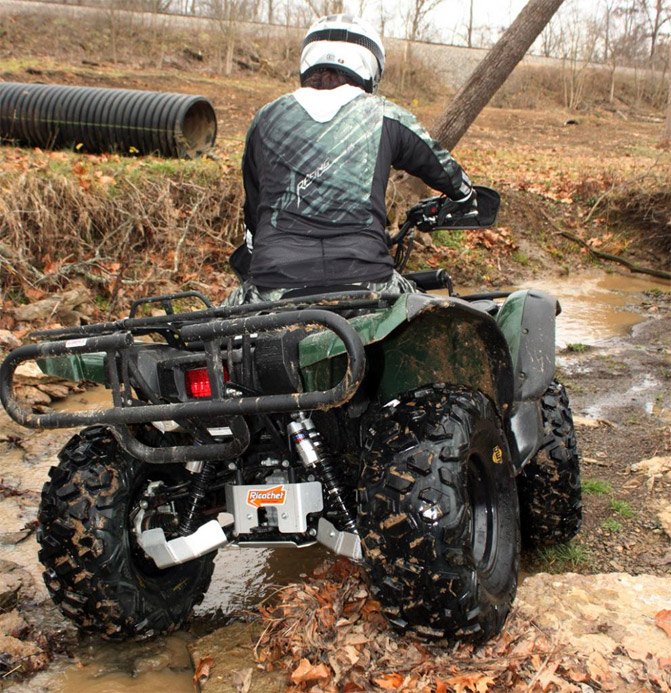
Always check the terrain advisedly earlier you beginning downwardly any hill. Cull a downhill path that is as straight every bit possible, with a minimum of obstacles. Shift your weight to the rear of the machine and use a low gear. On steeper downward slopes, straighten, just do not lock, your knees and elbows. Then bend forward sharply at the waist so that your posterior is over the back of the seat. Utilize both brakes to gradually slow downwardly.
When you go beyond a gradient rather than directly upwardly or down, information technology is called traversing and requires additional attention. Avoid traversing slopes with excessively slippery, rough, or loose surfaces.
Here are some bones guidelines for traversing:
- Lean your upper trunk uphill.
- When riding on soft terrain, you may need to turn your front end wheels gently uphill to keep your ATV on a straight line across the loma.
- If your ATV begins to tip, turn the front wheels downhill if the terrain allows. If the terrain does not let, dismount on the uphill side immediately.
- Avoid making sudden throttle changes.
Loma Drills
For this practice, select an easy hill, gratis of obstructions (piece of cake to climb on foot). Outset your arroyo to the hill by accelerating before the base of the hill. Shift into a lower gear at the base of operations of the hill if necessary to maintain momentum while climbing the colina. Plough the ATV to the left, in an arc, before yous reach the top. Keep turning, using your remaining momentum until you are facing downhill. During the turn, yous'll take to shift your weight to the uphill side of the quad.
Descend the hill in a lower gear, and as you lot descend, slow downwardly by applying the brakes. When going downhill, go along your weight to the rear of the machine. Then exercise with your weight to the right. The primal to successfully performing this practise is to shift your weight smoothly from forward (as you climb) to the uphill side (as y'all plough) and the rear (as you descend). For smooth weight shifts, rise up slightly off the seat.
To practice traversing, select an easy loma gratis of obstructions. Offset your approach and accelerate earlier the base of the hill. Plow the ATV to the left, ride beyond the slope, and and then ride down the hill. Repeat the exercise to the correct.
Quicker Stops and Quicker Turns
Existence able to make quick turns tin can come in existent handy when you lot need to avoid obstacles on the trail. Practice this by putting 5 markers down at 35-foot intervals. Travel to the left of the first marker and and so to the right of the second and continue until you attain the last marker. At first, practice at wearisome speeds, and and then gradually increment your speed. After you have mastered this, move the markers closer together. Exercise not move them closer than 18 feet apart.
The key to doing the quick plough practise is to shift your weight quickly to initiate the turn. To shift your weight effectively, rise upwards slightly standing on the footrests, quickly motion your hips, and lean your torso to the within of each turn. To get left, utilize a slight left turn to the front wheels, speedily lean left and apply a short outburst of throttle. To go right, practice the reverse. Do not look at the next marker you are budgeted. Look ahead and exercise not fixate on a marker.
How To Handle Obstacles
Information technology's inevitable that yous'll take to get over some obstacles out on the trails. Whether it'south a rut, boulder, log or ridge, there's a way to become over information technology smoothly and safely. Here's a step-past-step method of handling obstacles:
- Stand up on the seat as you approach the obstacle with your artillery and knees aptitude.
- Go along a firm grip on the handlebars to go along the ATV pointed straight ahead.
- Employ a small-scale corporeality of throttle as the front wheels meet the obstacle. Release the throttle as before long as the front wheels have gone over the obstacle.
- Lean forward slightly in one case the front wheels take gone over the obstacle in order to remove weight from the rear wheels. The throttle must exist released before the rear wheels hitting.
Choose a small obstacle for your initial practice. A modest oestrus, mound, or pocket-size log will work fine. Approach the obstruction at walking speed and as close to a 90-degree angle equally possible.
Trail Riding Strategies
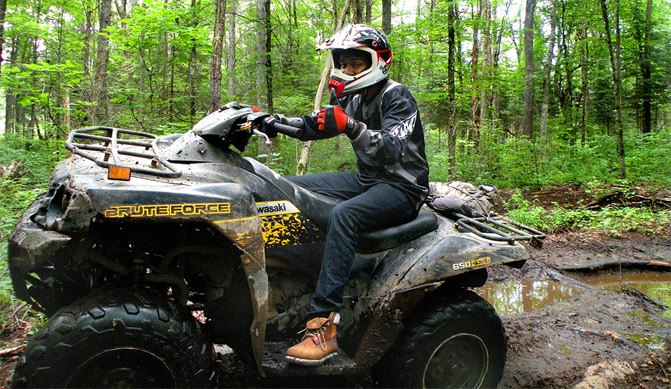
To get the most out of your ride, yous have to know the land you are riding on and what your machine can do. Carefully choose the places y'all ride. You should always utilize existing trails. Stay abroad from terrain where you do not vest, such equally unsafe slopes and impassable swamps. Watch carefully for sharp bumps, holes, ruts or obstacles.
An expert rider stays out of problem past handling the ATV well and avoiding whatsoever risky situation. Larn to read the trail every bit yous ride. An good rider looks well ahead on the trail. Know what is coming up and be prepared to react long before you go there. Be constantly alert for hazards.
Go at a speed that is proper for the terrain, visibility, operating weather and your experience. By scanning far plenty down the trail, you will be able to pick the best 'lines' (or safest paths of travel) around or over hazards or small obstacles. As you arroyo a hazard, do not fixate on it. Instead, continue to search for other clues in the environment and accommodate your speed well in advance.
Endeavour to Spot Troubles Ahead of Time
We already talked near the pre-ride inspection as far as the mechanical condition of the quad goes. Simply yous will too want to try and conceptualize trouble as it pertains to things yous've attached to your quad or your torso. ATVs have a tendency to shake things loose or move them around a lot more than than yous might think.
If you're wearing jeans, don't continue important things similar money and motorcar keys in your open up pockets. Put that stuff in a fanny pack or a zippered jacket pocket. Items strapped onto your racks—or in the instance of a sport quad, the rear catch bar—demand double the bungee cords you might expect.
Using Iv-Cycle Drive
Many of the quads on the marketplace today have a 2WD/4WD button. Every bit a novice rider, the question is, when you do utilise 4WD? Whatever time you're tackling obstacles that look a bit tough such every bit hillclimb, log, ledge, mud bog or rock field switch your ATV to 4WD. To feel the 4WD piece of work, cross a large log in 4WD and and so attempt it in 2WD and you should experience a dramatic divergence. And so why not proceed it in 4WD all the fourth dimension? When quads are in 4WD the steering requires more effort and gas mileage suffers, compared to 2WD. The 2WD manner besides allows y'all to slide around corners when the trail conditions are loose.
Using Reverse Gear
Nearly all quads have a opposite gear. The ATV manufacturers wisely installed rev-limiters that are activated when reverse is engaged, severely limiting your opposite speed. Why is that? Well, the treatment of a quad while traveling backwards is really funky and it'due south easy to loose control and tip over if y'all are going too fast.
However, there are times when you could employ more than power in reverse and many ATVs feature a reverse rev-limit override push. For case, you might be stuck in a nasty mud hole and want to opposite out to drier basis. With the rev-limiter boot in, you can't go out. Simply push the override push button every bit you requite the machine throttle and you'll get the horsepower to get you out of the state of affairs. Whatever you exercise, don't employ the override button to have a drag race in contrary with your riding partner. That will probably end with one of yous upside downwardly.
Hidden Obstacles
Many trails are but barely broad plenty for ATVs to go down. In the middle of summer when the weeds are at the height of their growth, they tin can hide big rocks and cut logs alongside (and sometimes in the middle of) the trail. Be careful when riding in dusty atmospheric condition too, as the dust tin can obscure large rocks on the trail. When it'southward dusty out, merely go along your distance from the rider in front to accept a more pleasant and safer ride.
Don't Go Rushed on Your First Trail Ride
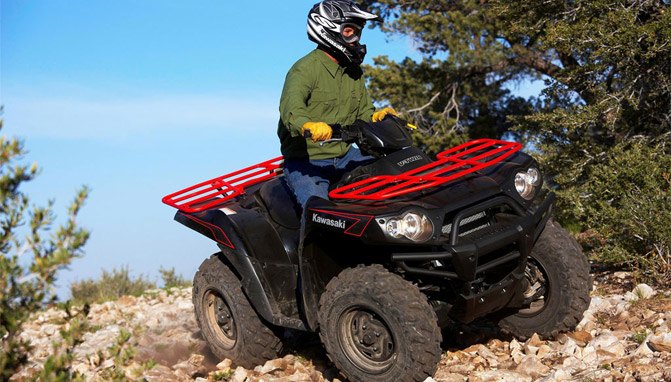
On your first trail ride, you should make sure that the people you're riding with understand you're a beginner rider and they shouldn't push you lot to go faster than what you're comfortable with. They should besides keep you on beginner terrain.
You, of course, will make the final decision as to how fast you lot go, so don't give in to peer pressure level in an effort to keep up with the residuum of the gang. You lot'll take plenty of opportunities later to show them how fine a passenger you've become. Information technology'due south all-time that y'all don't go with a big group of experienced riders on your starting time ride since you will feel like you take to keep up. Preferably, you want to accept someone leading the ride that will go on on an heart on yous and who will occasionally wait to check and come across if you need a physical or mental break. Yous may also want some other pal bringing upward the rear who won't ride too close to intimidate you. Call back, it's your peel on the line so don't let anyone talk you into going any faster than you desire.
Source: https://www.atv.com/products/basic-atv-riding-techniques-624.html
0 Response to "what should you do if your atv starts to tip while you are turning at a moderate speed?"
Post a Comment